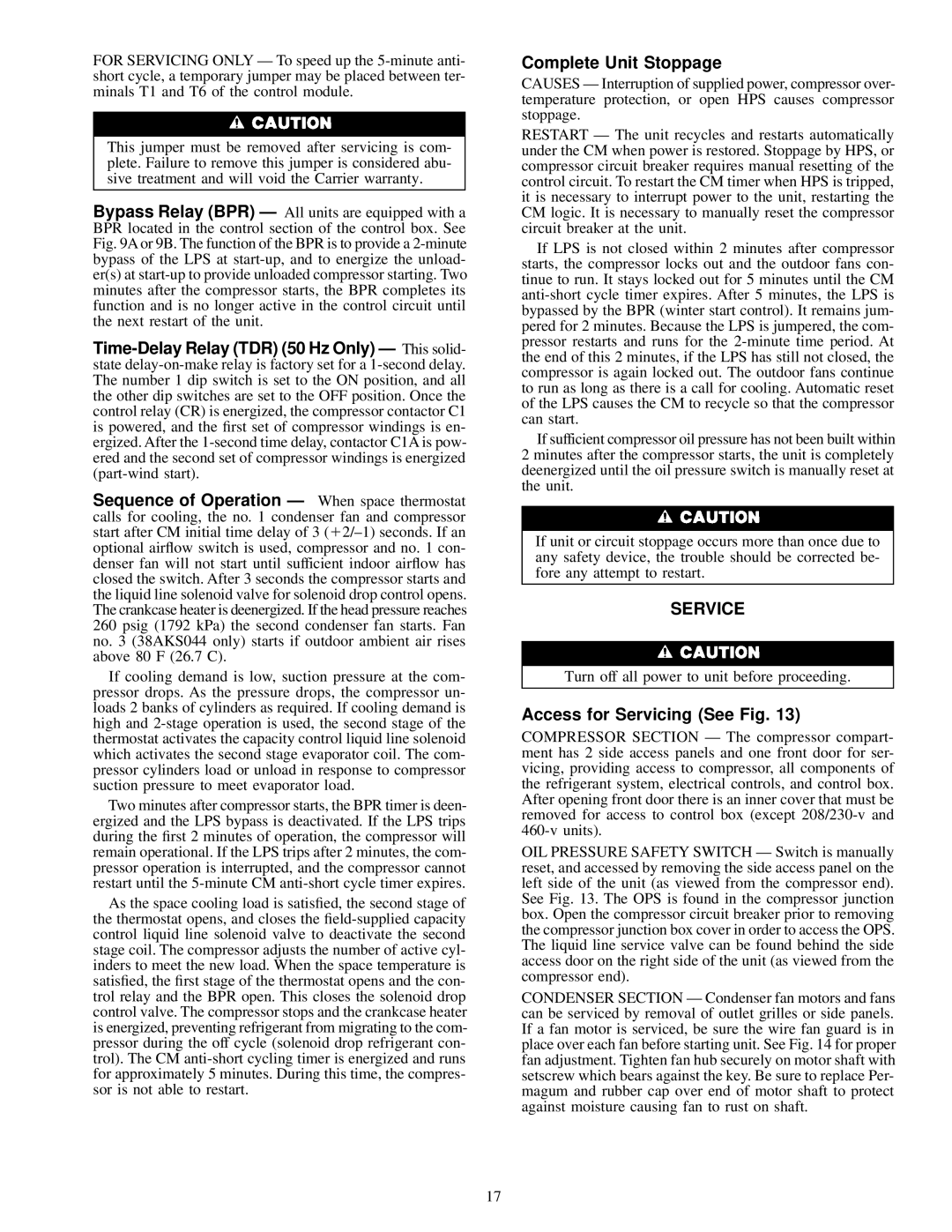
FOR SERVICING ONLY Ð To speed up the
This jumper must be removed after servicing is com- plete. Failure to remove this jumper is considered abu- sive treatment and will void the Carrier warranty.
Bypass Relay (BPR) Ð All units are equipped with a BPR located in the control section of the control box. See Fig. 9A or 9B. The function of the BPR is to provide a
Sequence of Operation Ð When space thermostat calls for cooling, the no. 1 condenser fan and compressor start after CM initial time delay of 3 (12/±1) seconds. If an optional air¯ow switch is used, compressor and no. 1 con- denser fan will not start until sufficient indoor air¯ow has closed the switch. After 3 seconds the compressor starts and the liquid line solenoid valve for solenoid drop control opens. The crankcase heater is deenergized. If the head pressure reaches 260 psig (1792 kPa) the second condenser fan starts. Fan no. 3 (38AKS044 only) starts if outdoor ambient air rises above 80 F (26.7 C).
If cooling demand is low, suction pressure at the com- pressor drops. As the pressure drops, the compressor un- loads 2 banks of cylinders as required. If cooling demand is high and
Two minutes after compressor starts, the BPR timer is deen- ergized and the LPS bypass is deactivated. If the LPS trips during the ®rst 2 minutes of operation, the compressor will remain operational. If the LPS trips after 2 minutes, the com- pressor operation is interrupted, and the compressor cannot restart until the
As the space cooling load is satis®ed, the second stage of the thermostat opens, and closes the
Complete Unit Stoppage
CAUSES Ð Interruption of supplied power, compressor over- temperature protection, or open HPS causes compressor stoppage.
RESTART Ð The unit recycles and restarts automatically under the CM when power is restored. Stoppage by HPS, or compressor circuit breaker requires manual resetting of the control circuit. To restart the CM timer when HPS is tripped, it is necessary to interrupt power to the unit, restarting the CM logic. It is necessary to manually reset the compressor circuit breaker at the unit.
If LPS is not closed within 2 minutes after compressor starts, the compressor locks out and the outdoor fans con- tinue to run. It stays locked out for 5 minutes until the CM
If sufficient compressor oil pressure has not been built within 2 minutes after the compressor starts, the unit is completely deenergized until the oil pressure switch is manually reset at the unit.
If unit or circuit stoppage occurs more than once due to any safety device, the trouble should be corrected be- fore any attempt to restart.
SERVICE
Turn off all power to unit before proceeding.
Access for Servicing (See Fig. 13)
COMPRESSOR SECTION Ð The compressor compart- ment has 2 side access panels and one front door for ser- vicing, providing access to compressor, all components of the refrigerant system, electrical controls, and control box. After opening front door there is an inner cover that must be removed for access to control box (except
OIL PRESSURE SAFETY SWITCH Ð Switch is manually reset, and accessed by removing the side access panel on the left side of the unit (as viewed from the compressor end). See Fig. 13. The OPS is found in the compressor junction box. Open the compressor circuit breaker prior to removing the compressor junction box cover in order to access the OPS. The liquid line service valve can be found behind the side access door on the right side of the unit (as viewed from the compressor end).
CONDENSER SECTION Ð Condenser fan motors and fans can be serviced by removal of outlet grilles or side panels. If a fan motor is serviced, be sure the wire fan guard is in place over each fan before starting unit. See Fig. 14 for proper fan adjustment. Tighten fan hub securely on motor shaft with setscrew which bears against the key. Be sure to replace Per- magum and rubber cap over end of motor shaft to protect against moisture causing fan to rust on shaft.
17
